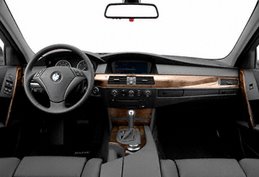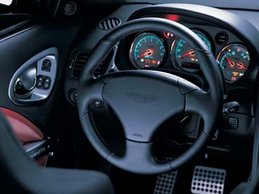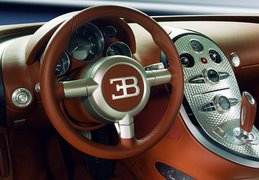 Cadillac CTS-V - One car is short a couple of doors. Another is no longer in production and cost some $23,000 more than either of the others. Ordinarily, we try to round up rides that are similar in concept, performance potential, and price. But with this trio, the only inescapable commonality is that they all aspire to be "ultimate driving machines."
Cadillac CTS-V - One car is short a couple of doors. Another is no longer in production and cost some $23,000 more than either of the others. Ordinarily, we try to round up rides that are similar in concept, performance potential, and price. But with this trio, the only inescapable commonality is that they all aspire to be "ultimate driving machines."Tuned on Germany's treacherous Nürburgring racetrack—the unforgiving development crucible employed by BMW, Porsche, and AMG, to name just a few—the Cadillac CTS-V is clearly the most ambitious effort General Motors has made to produce a sports sedan credible by BMW standards.
Did the Cadillac kids hit the 10 ring? Last year's Nürburgring preview of this Cadillac (September 2003) certainly seemed to suggest a serious contender had been created. But we were shown pre-production development cars, and the program didn't allow our formal testing procedures. This time around we put our hands on a sure-'nuff production sample, albeit an early one. So we rounded up the brace of Bimmers—an M3 from our friends at BMW of North America and, since BMW NA was fresh out, an M5 from our friend Dave Wexall.
With the preliminaries settled, including instrumented braking, skidpad, and straight-line acceleration, we saddled up and headed south—three jet-black bullets rumbling through the mists of a dank November morning. Not ideal for evaluating performance cars, but we had high hopes for the next day's visit to Putnam Park, a beautiful 1.77-mile road course about 20 miles west of Indianapolis. And from a performance point of view, we were counting on Putnam Park to provide the definitive story.
Another problem turned out to be virtual. After a few laps on the Putnam Park road circuit, long before the track had dried enough for us to turn meaningful lap times, the Caddy began reporting high oil temps. When the pavement dried, allowing go-for-it driving, we were unable to make more than two consecutive circuits before the display numbers soared north of 300 degrees Fahrenheit, accompanied by an insistent chime.
Nevertheles
 s, since we wanted the Caddy to survive the Putnam runs, we were cautious, limiting our lapping and short-shifting to keep the revs down. We feel certain a little more driving with a little less constraint would have produced better lap times.
s, since we wanted the Caddy to survive the Putnam runs, we were cautious, limiting our lapping and short-shifting to keep the revs down. We feel certain a little more driving with a little less constraint would have produced better lap times.The third problem we encountered was axle tramp, also known as wheel hop, during hard acceleration from a standing start, and it's one that can't be explained away so easily. Morris notes that with a judicious combination of clutch slip and wheelspin, GM development engineers have finessed 0-to-60 runs in the 4.5- and 4.6-second realm, which is pretty much what we anticipated with this car's Corvette powertrain. Unfortunately, we hadn't been to the GM school of CTS-V launch technique, so our efforts were rewarded by rear-wheel hop, with severity in direct proportion to the level of aggression employed to get the car out of the blocks. It soon became clear that further runs were likely to bring the test to a premature end, whereupon we left off.
As noted, the Caddy's sprints were not up to our expectations, and this applies to more than the 0-to-60 numbers. Despite the launch limitations, with the most potent power-to-weight ratio in the group and the shortest final drive, the CTS-V should have begun to assert itself once it got out of the starting gate. That was not the case. Although it was quicker than the M3 to 100 and 140, the Cadillac trailed the M5 in every acceleration category, and its 13.7-second elapsed time through the quarter was the slowest of the trio (the Caddy's trap speed was 107 mph compared with 106 for both the M3 and M5). In our September preview, we cited Cadillac's forecast of quarter-miles in the low-13-second range, with a trap speed of about 110 mph.
We don't think the leak had much effect on the braking numbers. The Cadillac was third among three, requiring 165 feet to stop from 70 mph, a foot longer than the M5, four feet longer than the M3, which weighs in 555 pounds lighter. Nevertheless, 165 feet is a sports-car number, and the CTS-V had distinctly better pedal feel than the M5.
Racetrack development notwithstanding, sports sedans have to provide driving pleasure across a broad range of categories—from something as simple as the feel and function of controls and switches to how well the seats accommodate their occupants in all kinds of driving to driver sightlines to ride quality to exhaust note. In this purely subjective realm, the CTS-V fared reasonably well against the Bavarians, a little soft in some areas, but superior in others.
Certainly, there's more to public-road driving than max cornering speeds and late braking. And in the realm of livability, the Cadillac gives a very good account of i
 tself. The front buckets don't offer quite as much lateral support as the M5's, but their range of adjustability is good, and if they give anything away in terms of all-around comfort, the distinction is academic. The M3's seats, in contrast, reflect the sportier nature of the car—almost raceworthy, but difficult to adjust and even harder to achieve long-distance comfort. We could wish that the Cadillac's steering column had a telescope feature as well as tilt, but no one reported any difficulties with achieving an optimal driving position.
tself. The front buckets don't offer quite as much lateral support as the M5's, but their range of adjustability is good, and if they give anything away in terms of all-around comfort, the distinction is academic. The M3's seats, in contrast, reflect the sportier nature of the car—almost raceworthy, but difficult to adjust and even harder to achieve long-distance comfort. We could wish that the Cadillac's steering column had a telescope feature as well as tilt, but no one reported any difficulties with achieving an optimal driving position.In terms of general comfort and self-indulgence, the CTS-V is a clear winner. It's roomier than the M5, particularly in the rear, the electroluminescent instruments look good and scan better, the interior styling looks more contemporary than the aging BMW layouts, and the Caddy's audio system makes the BMW units sound very ordinary indeed.













No comments:
Post a Comment